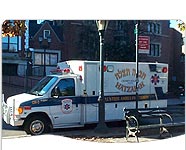





Never assume the obvious; your patient's life is at stake - MVC & AMS A single-vehicle MVC occurred one sunny spring afternoon on a notoriously dangerous, winding road. The car crossed the double yellow lines and hit a pole on the other side of the street. Non-involved witnesses are on scene. The posted speed limit is 45 mph. The first-due EMS and fire units arrive and begin evaluation and treatment. The vehicle did not have air bags, but the driver was wearing a seatbelt. The crew takes scene safety measures, begins assessing ABCs, conducts the primary survey and stabilizes the C-spine. Because of deformity of the front bumper and hood of more than 24", the patient requires extrication. The on-scene officer in- charge declares incident command (IC) and upgrades the call to a rescue box alarm. On arrival of the remainder of the rescue box assignment, the patient, who has been stuporous, becomes agitated and combative. His airway is stable, his breathing is unlabored, and he has slightly tachycardic peripheral pulses. The patient has a GCS of 12 (3/4/5) and no obvious focal neuro motor deficits. The EMS providers continue care while extrication begins. Due to the mechanism of injury (high-speed deceleration), the presenting findings (agitation and combativeness) and head trauma (facial lacerations with soft tissue swelling), the crews request a helicopter to transport the patient to a trauma center. Their working diagnosis is a severe closed-head trauma with increased intracranial pressure. A supervisor arrives on scene and learns that the 25-year-old male patient has been stabilized and immobilized for extrication. Vital signs: pulse 120 and regular, blood pressure 150/90, respirations 20 and unlabored, and 100% pulse oximetry on nasal cannula. GCS remains 12 (3/4/5); otherwise, the patient is neurologically grossly intact. The patient has suffered several facial lacerations and contusions, but crews have his bleeding under control. No obvious skull fracture, gross spinal deformities or crepitus is noted. The patient's airway is patent, and his lung exam is normal. His heart exam is normal, except for tachycardia. There are some bilateral chest abrasions/contusions and positive seatbelt signs, but no frank rib fractures. His abdomen is soft and apparently not tender. The extremities all move equally, with no gross deformity. The helicopter is 20 minutes out. Then someone recognizes the patient as a firefighter from a nearby station. An added measure of anxiety becomes evident on scene. Extrication continues, as do the patient's confusion and combativeness. A senior supervisor arrives on scene and is briefed on the status, treatment and transport plan for the member of his service. Mechanism of injury, vital signs, physical exam, pulse oximetry, ECG rhythm strip findings and the altered mental status (AMS)/closed head trauma working diagnosis are reviewed. A C-collar has been placed, and oxygen and IV fluids are running. As soon as extrication is complete, the providers plan to intubate the patient for airway protection during transport and to potentially begin treatment for increased intracranial pressure. The senior supervisor asks for a finger stick blood glucose (FSBG) test. He's concerned by the nature of the MVC- single vehicle, sunny day, young patient- and he wants to be as complete as possible in the field in evaluating an AMS patient. The FSBG is then completed and reveals a reading of 22. A 25 g dose of dextrose is administered via slow IV push. Within three minutes, the patient is alert and oriented times four. A repeat physical examination reveals a fully conscious, cooperative and coherent patient. Minor facial lacerations, contusions and various abrasions appear to be his only injuries. Normal sinus rhythm is noted on the monitor and BP is now 130/76. RR is 16 and unlabored. The helicopter transports the patient to a trauma center for evaluation. This patient has an uneventful overnight hospital stay and is discharged, ambulatory, the next morning. One week earlier, the patient had been newly diagnosed with non-insulin-dependent diabetes mellitus (NIDDM) and placed on an oral agent. The patient had taken his morning medication, but had not yet eaten lunch when the MVC occurred. This case illustrates the need to focus on presenting complaints rather than an incomplete diagnosis. In this case, the AMS caused the MVC, not the other way around. The AMS was caused by hypoglycemia, resulting from improper diet following ingestion of hypoglycemic agents for treatment of NIDDM. It would have been poor medical care and professionally embarrassing for this patient to arrive at a trauma center with untreated hypoglycemia as his only cause of AMS. JEMS Paul A. Matera, MD, EMT-P, is a fire surgeon with Anne Arundel County Fire Department and a police surgeon with Maryland Natural Resources Police. He also chairs the Street Medicine Society. Contact him at pmateraMD@aol.com.
footnotes:
|
Home - About Us - Courses - Donate - Members - Safety Tips - Medical Digest
What is an Emergency? - Contact Us - Member Login - News - Photo Album
© Copyright 2003 - 2004 Hatzalah of Crown Heights
Design by Unique Image Advertising